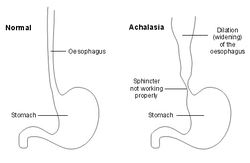Pathological definition - Achalasia

Achalasia
Achalasia is a disorder which affect the motility of the esophagus. Clinically achalasia is presented as gradual and progressive difficulty in swallowing both liquids and solids which is common in older people. The main causes of achalasia is remain unknown. Achalasia remains an idiopathic disorders. Patient may also present with fullness and pain in the substernal region after meal. Regurgitation of an undigested food is also common.
Achalasia is treated with surgical myotomy, pneumatic dilation of the lower esophageal sphincter and injection of the botulinum toxin.
Pathologically, achalasia is presented with dilation of the esophagus above the lower esophageal sphincter. The dilated esophagus is present with distal stenosis or bird beak/rat tailed lower esophageal sphincter in barium esophageal swallow imaging study. In the esophageal wall, there is also an absence of the ganglionic cells of the myenteric plexus. The absence/loss of the ganglionic cell of the myenteric plexus may lead to loss of peristalsis in the distal two third of the esophagus mostly affecting the smooth muscle which finally lead to impaired relaxation of the lower esophageal sphincter.
Achalasia also carries a high risk of developing squamous cell carcinoma
Achalasia is often mistaken with other disorders which affect the function and motility of the esophagus such as spams of the esophagus, tumors, Changas disease and scleroderma.
References
1.Cassella, Robert R., Arnold L. Brown, George P. Sayre, and F. Henry Ellis. “Achalasia of the Esophagus Pathologic and Etiologic Considerations.” Annals of Surgery 160, no. 3 (September 1964): 474–486.
2.Richter, Joel E. “Oesophageal Motility Disorders.” The Lancet 358, no. 9284 (September 2001): 823–828. doi:10.1016/S0140-6736(01)05973-6.
Achalasia is a disorder which affect the motility of the esophagus. Clinically achalasia is presented as gradual and progressive difficulty in swallowing both liquids and solids which is common in older people. The main causes of achalasia is remain unknown. Achalasia remains an idiopathic disorders. Patient may also present with fullness and pain in the substernal region after meal. Regurgitation of an undigested food is also common.
Achalasia is treated with surgical myotomy, pneumatic dilation of the lower esophageal sphincter and injection of the botulinum toxin.
Pathologically, achalasia is presented with dilation of the esophagus above the lower esophageal sphincter. The dilated esophagus is present with distal stenosis or bird beak/rat tailed lower esophageal sphincter in barium esophageal swallow imaging study. In the esophageal wall, there is also an absence of the ganglionic cells of the myenteric plexus. The absence/loss of the ganglionic cell of the myenteric plexus may lead to loss of peristalsis in the distal two third of the esophagus mostly affecting the smooth muscle which finally lead to impaired relaxation of the lower esophageal sphincter.
Achalasia also carries a high risk of developing squamous cell carcinoma
Achalasia is often mistaken with other disorders which affect the function and motility of the esophagus such as spams of the esophagus, tumors, Changas disease and scleroderma.
References
1.Cassella, Robert R., Arnold L. Brown, George P. Sayre, and F. Henry Ellis. “Achalasia of the Esophagus Pathologic and Etiologic Considerations.” Annals of Surgery 160, no. 3 (September 1964): 474–486.
2.Richter, Joel E. “Oesophageal Motility Disorders.” The Lancet 358, no. 9284 (September 2001): 823–828. doi:10.1016/S0140-6736(01)05973-6.
